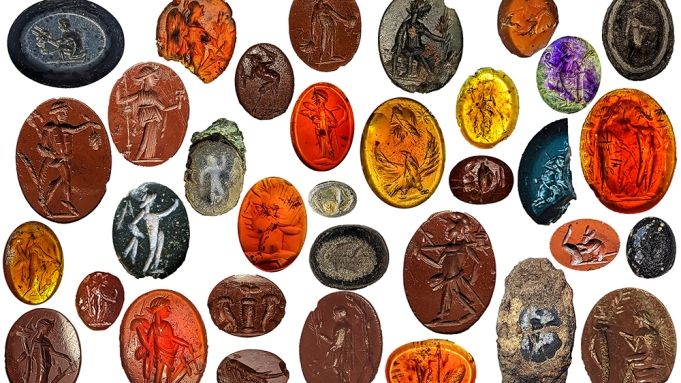Archaeologists Found Gemstones at an Ancient Roman Bathhouse
Nowadays, you likely secure your valuable jewelry before a trip to the spa. But ancient Romans may not have taken that extra step before enjoying a hot bath.
Recently, archaeologists in Britain discovered dozens of engraved semiprecious stones from the third century at the site of an ancient bathhouse beneath the Carlisle Cricket Club, The New York Times reported. Smaller than a dime, the 36 gems are made of materials like amethyst, carnelian, and jasper. Called “intaglios,” meaning they have images carved into them, the jewels likely fell out of wealthy people’s rings after they entered the baths, the Times noted.
“The bathers may not have even noticed until they got home, because it’s the actual stone falling out of the rings,” Frank Giecco, the technical director of the project, told the newspaper.
Venus holding a mirror on an amethyst gem Anna Giecco
The bathhouse, located near Hadrian’s Wall in Carlisle, England, was apparently a massive structure. During a visit, ancient Romans would have first popped into the apodyterium, or changing room, where they would have removed all of their clothing except for their bath sandals, to protect their feet from the heated floors. Some would have slaves or the bathhouse attendants look over their belongings, but others kept their jewelry on to prevent theft.
“Bathers knew the risk of gems falling out,” Giecco said. “But theft from the lockers was so great that they kept valuables with them regardless.”
While that seems smart in theory, the water may have loosened the adhesives used in the rings—like birch bark resin—and caused the metal settings to expand and contract. So the stones probably just fell off, sinking to the bottom of the baths and ending up in the drains when the pools and saunas were cleaned.
Diana drawing an arrow from her quiver. Made from Cornelian. Anna Giecco
Along with the gems, archaeologists found more than 700 items at the Carlisle site. Among those were glass beads, pottery, clay figures, tiles, and more than 100 hairpins. Those latter accessories led Giecco to assume that the owners of the stones were likely women.
While this is a delightful find in the archaeology world, let it also serve as a reminder to keep track of your valuables before you go for a dip. Otherwise your gold and diamonds might become a fun discovery for another group of researchers several centuries from now.
Source: Robb Report


